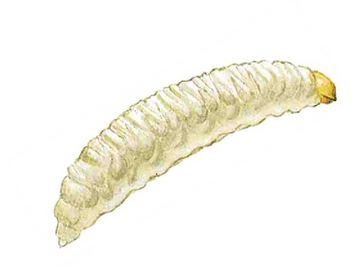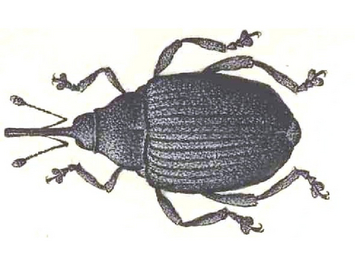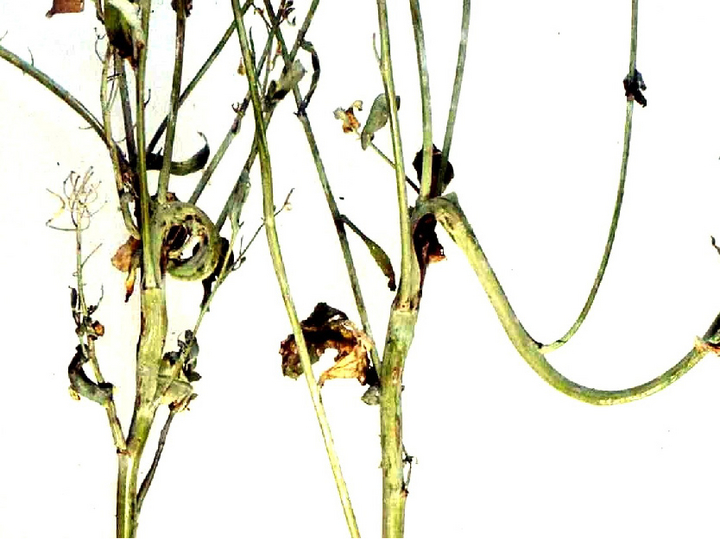Cabbage stem weevil
Ceutorhynchus napi
Profile
In oilseed rape fields, several species of weevils are found whose larvae live in the rapeseed stalks; for example, the small or spotted cabbage stem weevil(Ceutorhynchus pallidactylus Marsham, 1802). In the following, only the large rape stem weevil(Ceutorhynchus napi Gyllenhal, 1837) is described, as it causes the most extensive damage.
Appearance


The larvae are legless, yellowish-white and have a light brown head capsule.
The head of the beetles, which are only 4 mm in size, is trunk-shaped elongated and bears kneaded, seven-limbed antennae. Its dark body surface is strongly sclerotized and covered with regularly arranged whitish scale hairs, so that it appears gray striped.
Biology
The adult beetles overwinter fully developed partly in the pupal cradles of the previous year, but also in sheltered places such as the ground litter of bushes, forest edges or hedges. As soon as the air temperature exceeds 12 °C, the females begin to fly to rapeseed fields. This is usually the case from March onwards, although in very warm years (e.g. 2024) this is also possible as early as February.
After about ten days of maturing feeding, the female gnaws holes in the rapeseed stalk to lay her eggs and secretes a chemical substance that stimulates the plant tissue to form tissue growths. The female then lays one egg in each of these cavities and the tissue heals again. The transparent eggs are completely concealed in the leaf tissue. Each female lays an average of 150 eggs. About six days after laying the eggs, the larvae hatch and begin to feed inside the stems. They create feeding tunnels in which they slowly work their way towards the ground.
To pupate, the larvae leave their host plant and turn into pupae in a small burrow they have dug themselves. However, some adult beetles do not leave this pupal cradle until the following spring.
Damage symptoms

In April and May, feeding tunnels with beetle larvae can be found on canola stems. Often numerous larvae live in each stem, so that such shoots then appear really hollowed out. Often there is also a bending of the shoot and a bursting of the stem.
Host plants
The pest lives on a wide variety of cruciferous species. Which ones are attacked depends primarily on their availability. For example, in early spring after overwintering, mainly winter rape and cabbage seed bearers are present. Cabbage vegetables, horseradish or radishes, on the other hand, are only attacked later by stragglers.
Economic importance
Maturation feeding by females prior to oviposition on leaves is rather insignificant. However, the chemicals secreted during oviposition cause tissue growth on the stems, which can lead to cracking and buckling of the canola plants. The canola plants damaged in this way are further weakened by subsequent frost or drought and may thus be severely reduced in yield.
Prevention and control
- Control measures on oilseed rape are carried out by chemically controlling the adult beetles with products against oilseed rape stem weevils or biting insects on oilseed rape (see list of plant protection products authorised in Austria).
- The best time for application is in early spring as soon as the first beetles are flying but no eggs have yet been laid. The eggs and larvae are very well protected in the rapeseed stalks and cannot be controlled chemically. However, if the treatment is carried out too early, when the flight from the winter quarters is not yet complete, a second treatment may have to be carried out.
- To determine the flight of the rape stem weevil, yellow, water-filled coloured trays are placed in the rape field. These "yellow trays" must be placed in a warm spot in the oilseed rape crop and checked daily for beetles. It is advisable to add a few drops of washing-up liquid and a little spirit. This will prevent the water from freezing on cold nights. Rapeseed weevils can be easily caught in yellow trays when they fly in. This is no longer the case once they start laying their eggs.
- The threshold value for spraying measures quoted in the literature is around three beetles per yellow tray per day. However, the locally adapted threshold value can deviate from this and be considerably higher. It is advisable to keep precise records of the success of the measure so that experience is retained for future years.
Last updated: 11.12.2025
automatically translated